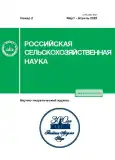In sweet cherry varieties cultivated in foothill Dagestan, to establish their selection and technological priorities, the mineral composition was studied, the content of sugars and acids was determined by generally accepted analysis methods. The subjects of the study were fruits of 8 introduced and 12 local breeding varieties of sweet cherries, which, depending on the variety, contained: potassium 80.6- 312.5; calcium 10.0-35.6; sodium 9.4-48.9; magnesium 7.7-21.2; phosphorus 25.6-55.1; iron 0.19-1.02; copper 0.08-0.63; manganese 0.11-0.68 and zinc 0.31-0.94 mg%. The best in terms of the total supply of macroelements in fruits were varieties: Gudzon - 427.7; Valeriy Chkalov - 335.2; Vinka - 320.8; Lezginka- 294.6; Durona de Vinola (sek.) - 284.3; Dagestanskaya chernaya - 271.4 and Pozdnyaya Lermontova - 271.0 mg%. A large amount of microelements (2.18-1.79 mg%) were found in the fruits of the varieties Valeriy Chkalov, Gudzon, Durona de Vinola (sek.), Krupnoplodnaya, Bigarro Krainskogo, Dagestanskaya rannyaya, Dagestanskaya chernaya and Pozdnyaya Lermontova. Most varieties of sweet cherries: Polyanka, Gudzon, Vinka, Romantika, Bigarro Krainskogo, Buynakskaya chernaya, Lezginka, Leningradskaya gvardeyskaya and Pozdnyaya Lermontova, the total amount of sugars ranged from 11.2-12.8 %, and the concentration of acids was 0.63-1.10 %. The most promising for the optimization of the industrial variety of sweet cherries in the conditions of Dagestan, the use in selection work and the design of new specialized food products, were the varieties Valeriy Chkalov, Vinka, Durona de Vinola (sek.), Gudzon, Krupnoplodnaya, Bigarro Krainskogo, Dagestanskaya chernaya, Lezginka and Pozdnyaya Lermontova, distinguished by the greatest ability formation of mineral substances, sugars and acids in fruits.
 3-6
3-6


 7-10
7-10


 11-15
11-15


 16-20
16-20


 21-24
21-24


 25-29
25-29


 30-34
30-34


 35-39
35-39


 40-44
40-44


 45-51
45-51


 52-57
52-57


 58-62
58-62


 63-67
63-67


 68-71
68-71











